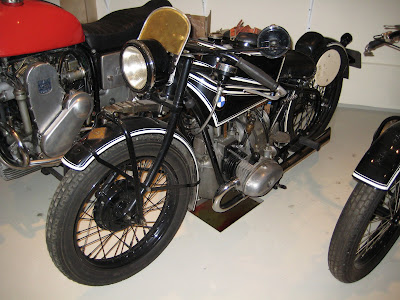
When researching the Fritz Ehn collection coming up for sale at Bonhams in June (see previous post), I mentioned the BMW R57 which is estimated to fetch £20,000. It looks like a decent machine, but I've only seen a photo, so don't take my word for it. I would assume since Mr Ehn likely purchased the bike in the early 1980's, that it's an older restoration using original parts. Nowadays I believe one can buy everything from the frame to the crankcases for the R57 and R63 (it's 750cc ohv brother - see my earlier post on the one I briefly owned); in fact I've heard that complete replicas are being made.
Which makes an older restoration, or better yet an original machine, so much more valuable. I visited pictured BMW in Leichtenstein last April, where it's kept company by a vast private collection. Sandwiched between an RS54 Rennsport and a Munch Mammut, it captivated my interest.

Clearly a racing machine, ca 1928, it is unrestored and bristling with cool accessories. Surprisingly for a racing bike, it has full Bosch electrics, plus a speedo driven from the gearbox (the drive tower can be seen on top of the gear casing in the 4th photo).
Most R57's have a single carb atop the gearbox, with two long induction tubes, which tend to ice up, but this machine has twin Amal-Fischers (Amal carbs made under license, with metric threads).

The one-piece exhausts have slow-taper megaphones, which was typical of BMW racers prewar. A small celluloid windscreen sits atop the handlebars, which have a twin-pull twistgrip for the dual carb setup (my R63 had a lever throttle for its single carb). The most obvious addition is the large secondary petrol tank sitting on the frame rails, which must connect to the lower tank as it obscures the filler cap. A leather chin pad (chest pad?) tops off the wedding cake of tanks.
I didn't get a good shot of the bronze badge on the front mudguard, which commemorates one of the early 30's races in which this bike competed (I have to admit being a bit overwhelmed from looking at over 400 machines).

The R57 has a 'square' bore and stroke at 68mm, and uses a 3 speed gearbox driven through a single-plate clutch. The front forks are trailing-link with leaf springs (nickelled, in this case) controlling movement. Leaf springs have an inbuilt self-damping capacity. so friction dampers aren't usually necessary. The frame is a welded-up twin loop, very advanced for the day, and very light. BMW would adopt pressed-steel frames in 1929, before returning to welded loops for the R5 /R6 in 1936.
The front brake is a typical 7" single leading shoe with cast iron drum and aluminum brake plate, but the rear brake isn't on the back wheel - it's on the driveshaft! An external band lined with friction material clamps onto steel drum on the gearbox output shaft - the brake pedal acts directly on this clamp and sits at 90 degrees to the lower frame rail - if you click on the second pic you can just see it jutting out below the little finned brake behind the gearbox. It
 works - I've never tried using it in anger though, and would imagine the small diameter (about 4") would lead to rapid fade.
works - I've never tried using it in anger though, and would imagine the small diameter (about 4") would lead to rapid fade.The standard R57 weighed in at 330lbs and produced 18hp, enough for about 75mph; with a twin-carb setup, an open pipe, and a racing cam, more like 24hp would be available. The 'Werks-Rennmaschine' produced 28hp - the 750cc version made 40hp.
In 1927, the BMW factory developed this machine further for their works' racing team and for record-breaking, grafting a Zoller supercharger on top of the gearbox. In this guise it was immediately successful in the Targa Florio and other events. In 1935 Ernst Henne would take this machine, still using the flat-tank chassis and leaf sprung forks (although with streamlining), to the world speed record at 159.10mph.

